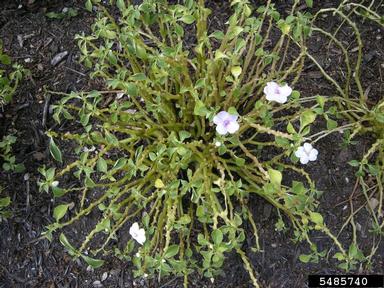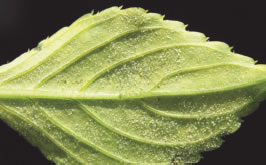DACF Home → Bureaus & Programs → Bureau of Agriculture → Division of Animal and Plant Health → Horticulture → Grower Resources → Impatiens Downy Mildew

Impatiens Downy Mildew Resources for Greenhouses
Disease Facts
- Caused by: The water mold Plasmopara obducens,
- Hosts: All varieties of garden impatiens, Impatiens walleriana and balsam impatiens, Impatiens balsamina. Wild jewelweeds are also susceptible.
- Non-Hosts: New Guinea impatiens, Impatiens hawkeri, and other plants are NOT affected.

- Symptoms: Yellowing of the upper leaf surface and downward curling foliage. Early symptoms may resemble nutritional problems, but undersides of leaves are covered in a white fuzzy growth. As the disease progresses leaves and flowers drop, leaving bare stems behind. Eventually the entire plant collapses.
- Spread: Spores in water splashed from nearby infected plants, spores blown long distances by the wind or spores that over wintered in the garden soil. Movement of infected plant material also facilitates the spread of the disease.
- Environment: Wet, humid conditions.
- Prevention: Avoid growing impatiens in environments where leaves stay wet for long periods of time such as in dense shade, or crowded plantings with poor air circulation. Avoid overhead irrigation and water plants early in the day when foliage has plenty of time to dry before nightfall. Inspect incoming shipments carefully and regularly scout the greenhouse, immediately remove any suspicious plants. Consider growing impatiens downy mildew resistant varieties.
- Treatment: Infected plants will not recover. Immediately remove plants with symptoms, including roots, bag and discard. Do not compost plants with impatiens downy mildew. Advise customers to not replant impatiens on sites where infected plants have been observed in the past. Aggressive preventative fungicide programs can be employed in the greenhouse to prevent disease.
- Alternative Plants: Substitutes for impatiens include begonias, coleus and New Guinea impatiens.
*Photo Credits: Mary Ann Hansen, Virginia Polytechnic Institute and State University,
Don Ferrin, Louisiana State University Agricultural Center
www.bugwood.org